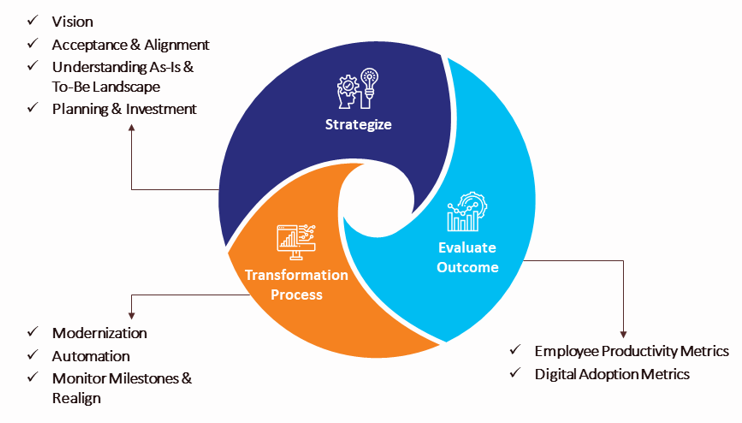Digital Transformation: Citius, Melius, Vilius
Olympic games, a symbol of endurance, glory, and striving against all odds to be citius, altius, fortius (faster, higher, stronger), offer a fascinating parallel to today’s IT business landscape. The competition in our IT industry is verily like the modern Olympics, where only gold, silver, and bronze matter. In other words, organizations that stay ahead of the curve, adapt/transform the fastest, and deliver at the speed of demand stay in business.
Today, every customer expects continuous value-added services through innovation and transformation. Transformation as a Service (TaaS) is the new unstated demand from our customers.
IT digital transformation is defined as “a complete reassessment and overhaul of an organization’s information technology (IT) systems in order to improve the efficiency and delivery in a digital economy.”
The starting point for any successful digital transformation is a combination of:
- Vision: Transformation starts with a vision, with the desired result in mind. A quantified ROI or visible business benefit from the transformation exercise should be the decisive factor to proceed.
- Acceptance and Alignment: To stay ahead in business, an organization needs to continually evolve and adopt new digital solutions for its customers. This vision must be accepted and percolated by every associate in the organization. Additionally, customers, vendors, and business partners need to align to partner effectively throughout the digital transformation journey.
- Understanding the As-Is and To-Be: A thorough understanding of the business and technology landscape is critical to start with; later, mapping can be done seamlessly to ensure business continuity and optimization. Critical information that needs to be considered as part of this As-Is phase includes:
- Line of business, region, and list of business owners
- Assessing existing portfolios, infrastructure, and applications (ERP/non-ERP), including legacy applications
- Understanding interfaces between the source and target systems
- Integration types (middleware, point-to-point)
- Types of information/data flow between the source and target systems
- Criticality level of each integration (high/medium/low)
- Whether the existing systems or applications are to be migrated/retired in the near future (and the number of legacy applications)
- Volumetric data (number of inbound/outbound transactions per fixed time period)
- Understanding the current application stability (volume of support tickets, change requests, and bugs); also, detailed analysis of the existing integration-related issues (i.e., connectivity, platform, data related) is beneficial
- Planning and Investment: Based on the system As-Is understanding, a roadmap needs to be chalked out, and key milestones in the journey identified. A thorough investment analysis of the cost projections, including CAPEX and OPEX, needs to be done and presented to get the buy-in of the decision-makers. Investment should be in the right technology and the right resources. This transformation initiative must be considered a critical high-visibility project. A manager who drives this initiative, along with a competent team, needs to be identified upfront and introduced to all the stakeholders.
Execution of the transformation program can be done phase-wise depending on business criticality. The focus should be on:
- Modernization: Adopting an agile methodology focused on continuous integration and delivery for both cloud-based and traditional applications; and evaluating and migrating outdated software/legacy systems, platforms, or applications from the on-premises server to the cloud.
- Automation: Identify areas of automation and set up a team to iteratively design, code, and test.
- Monitoring milestones and reviewing the outcomes against set goals, focusing on continuous optimization. Collaborative teamwork is vital at every stage.
The following KPIs will help measure the benefits of transformation:
- Employee productivity metrics: These would be the best and easiest metrics derived through monitoring and analysis of the volume of output an employee delivers post transformation compared to the past. The difference in revenue generated by the workforce can help quantify the benefits of the digital transformation program.
- Digital adoption metrics: A high digital adoption rate is another key indicator of successful digital transformation. In case of poor adoption and performance rate, we need to analyze and understand the reasons. For example, if poor adoption is due to complex functionalities or lack of user-friendliness, further optimization is called for.

Each phase of the transformation engages new capabilities that open more opportunities for further transformation. Thus, transformation is an iterative process.
The visible benefits of digital transformation are improved efficiency and transparency, revenue growth, cost savings, flexibility in business, better workforce engagement, and better customer experience.
Successful digital transformation is poised to create more revenue from digital investments. As per Statista, direct investments in digital transformation are estimated to touch USD 7 trillion in the next four years [1]. To maximize ROI, organizations are in the process of directing their workforce toward the adoption of new digital tools.
Organizations are embracing digital transformation to revamp their image with innovative products and services and better ways of working through agile organizational models focused on technology, people, and process. Digital transformation helps organizations keep pace with the emerging, fast-changing customer demands and thrive in a highly competitive business environment driven by their motto of Citius, Melius, Vilius (Faster, Better, Cheaper/Cost-efficient).
References
https://www.statista.com/statistics/870924/worldwide-digital-transformation-market-size/
Latest Blogs
Introduction What if training powerful AI models didn’t have to be slow, expensive, or data-hungry?…
Pharmaceutical marketing has evolved significantly with digital platforms, but strict regulations…
Leveraging the right cloud technology with appropriate strategies can lead to significant cost…
Introduction The financial industry drives the global economy, but its exposure to risks has…




